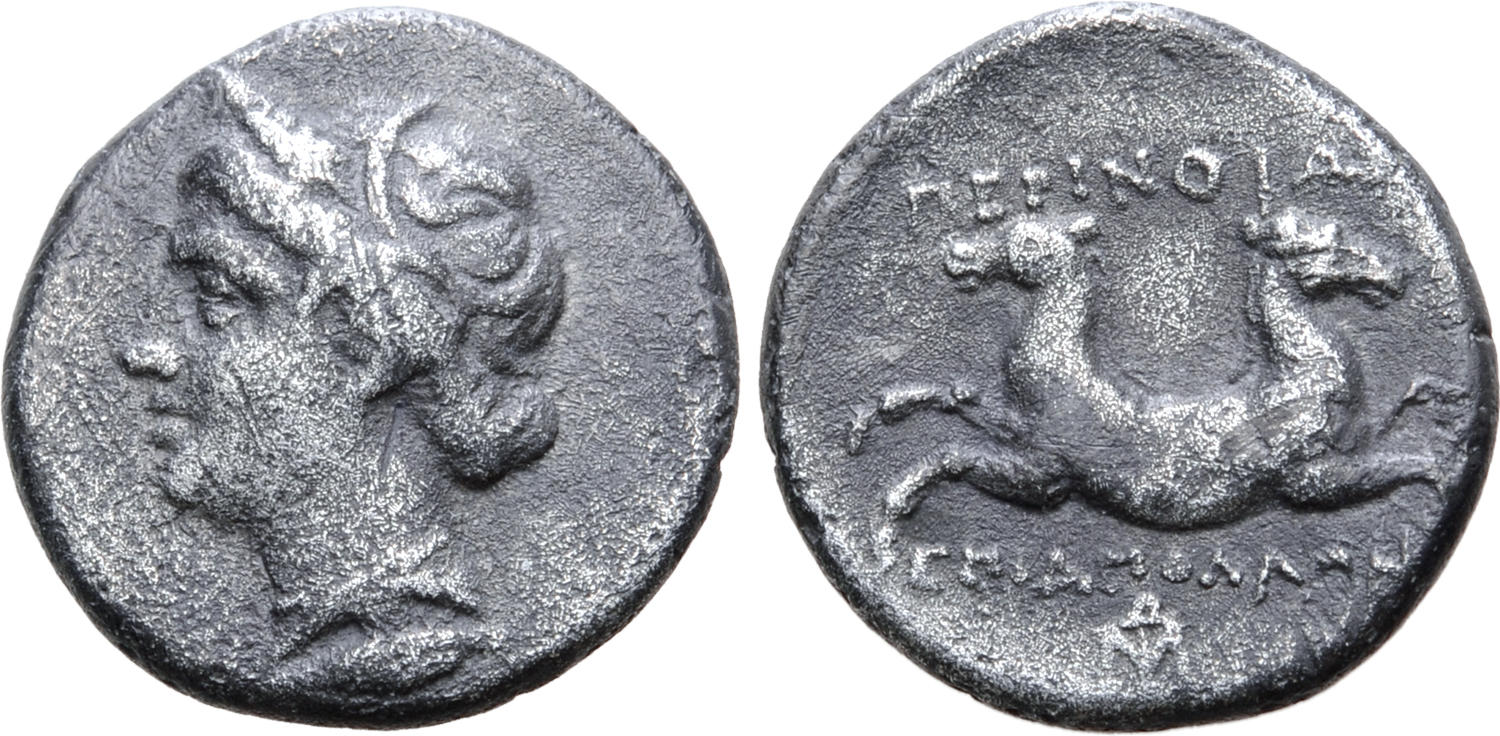Perinthus, silver, hemidrachms (Persephone/horse foreparts) (357-338 BCE)
From SILVER
357 BCE - 338 BCE Silver 199 kg
Description
| ObverseInscription or printing placed on the obverse.: | Wreathed head of Persephone to left, wearing necklace. |
| ReverseInscription or printing placed on the reverse.: | ΠΕΡΙΝΘΙΩ[Ν], ΕΠΙ ΑΠΟΛΛΟΝ (Greek).Conjoined horse foreparts prancing left and right, ΠΕΡΙΝΘΙΩ[Ν] above, ΕΠΙ ΑΠΟΛΛΟΝ over monogram below. |
Mint and issuing power
| MintIdentifies the place of manufacture or issue of a numismatic object.: | Perinthus | Ancient regionAncient region.: | Thrace | Modern countryModern country: Turkey | AuthorityIdentifies the issuing power. The authority can be "pretended" when the name or the portrait of X is on the coin but he/she was not the issuing power. It can also be "uncertain" when there is no mention of X on the coin but he/she was the issuing power according to the historical sources: |
Chronology
| FromIdentifies the initial date in a range assigned in a numismatic context. | 357 BCE | toIdentifies the final date in a range assigned in a numismatic context.. | 338 BCE | PeriodTime period of the numismatic object.: Classical 480-323 BC |
Physical description
| MetalThe physical material (usually metal) from which an object is made.: | Silver |
Median weightMedian of the weights of numismatic objects (in grams). in grams | 2.60 | DenominationTerm indicating the value of a numismatic object. Examples: tetradrachm, chalkous, denarius.: | hemidrachm |
StandardStandard.: |
Image

AC142a Perinthos.jpeg [1]
References
| Die study referencePublication of the study: | Schönert-Geiss 19651Schönert-Geiss 1965, n° 3-6. | ||
| Coin series referenceReference to coin series study: | HGC 3.22HGC 3.2, n° 1607, RQEMAC3RQEMAC, n° 142a | ||
Obverse dies distribution
no distribution is available
Reverse dies distribution
no distribution is available
Quantification
| Number of obversesNumber of obverse dies. ᵖ (o) | 3 | Number of singletons (o1)The number of singleton coins. ᵖ | |
| Number of reverse diesNumber of reverse dies. (r) | 3 | Number of coinsNumber of coins. (n) | 9 |
| Coins per obverse dieNumber of coins per obverse die. (n/o) | 3 | Coins per reverse dieNumber of coins per reverse die. (n/r) | 3 |
| Reverse per obverse ratioRatio of obverse dies divided by reverse dies. (r/o) | 1 | Percentage of singletons (o1)number of coins (n) divided by the number of singletons (o1) ᵖ | % |
| Original number of dies (O) (Carter 1983 formula)The estimation of the number of coins according to Carter 1983 ᵖ | 3.82 | Coins struck if 20,000 as average productivity per dieCoins made if the average productivity for obverses (according to Carter) is 20,000. ᵖ | 76,400 |
| Original number of dies (O) (Esty 2011 formula)The estimation of the number of coins according to the singleton formula in Esty 2011 ᵖ (O) | 4.5 | Survival rate if 20,000 as average productivity per dieSurvival rate if average productivity is 20,000. ᵖ | 0.00012 |
| Coverage (o = % of O) (Esty 1984 formula)Esty 1984 - coverage (% of O) ᵖ (o = % of O) | % | Die productivity if survival rate 1/2,000Average productivity if survival rate is 1/2,000. ᵖ | 4,712.04 |
| Weight of silver (in kg) if 20,000 coins per die (O = Carter formula)Carter 1983 * Median weight * 20000 (*10 if gold or electrum) ᵖ | 199 kg <br /> 199 kg | Die productivity if survival rate 1/5,000Average productivity if survival rate is 1/5,000. ᵖ | 11,780.1 |
Remarks
References
- ^ Schönert-Geiss Edith (1965), Die Münzprägung von Perinthos, Deutsche Akademie der Wissenschaften zu Berlin. Schriften der Sektion fur Altertumswissenschaft 45, 2 vol., Berlin
- ^ Hoover, Oliver D. (2017), Handbook of Coins of Macedon and Its Neighbors. 3. Part 2: Thrace, Skythia, and Taurike, Sixth to First Centuries BC, Lancaster-London, xix, 232 p.
- ^ Callataÿ, François de (2003), Recueil quantitatif des émissions monétaires archaïques et classiques, Numismatique Romaine, Wetteren, VII + 267 p.